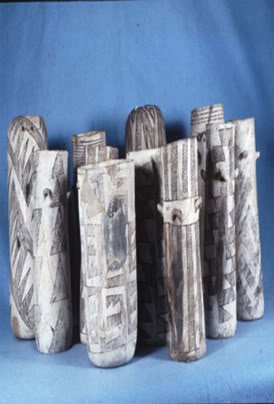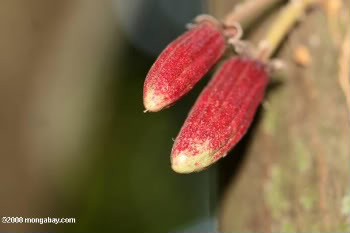|
|
Chocolate, produced from cacao beans, has been a part of American culture for a thousand years according to new paper published in the Proceedings of the National Academy of Sciences. Analyzing chemical residue from jars of native peoples in New Mexico, researchers Patricia Crown and Jeffrey Hurst discovered theobromine, a chemical signature of cacao. The jars have been dated from 1000 to 1125 AD, well over three hundred years before Columbus and the earliest recorded discovery of cacao north of Mexico.
The cacao jars are from Pueblo Bonito, an archaeological site in Chaco Canyon, which is located in northwestern New Mexico. Chaco Canyon, once home to 2,000-5,000 inhabitants, was composed of a dense group of pueblos, of which Bonito was the largest. Incorporating 800 rooms, Pueblo Bonito was the center of a number of towns and villages in Chaco Canyon.
 Twelve cylinder jars from Pueblo Bonito housed in the Smithsonian Institution Department of Anthropology. Vessel in left center is 21.5 cm in height. Photo courtesy of American Antiquity.. |
Taller than wide, the special cylinder jars containing the cacao have been found almost no-where else in the American Southwest. The uniqueness of these containers, according to researchers, suggests that the practice of drinking chocolate in Chaco Canyon was intimately tied to the Mesoamerican rituals regarding the drink.
“The likely association of cacao with cylinder jars at Pueblo Bonito suggests that knowledge concerning the proper preparation, serving, and consumption of cacao beverages accompanied the seeds from Mesoamerica,” Crown and Hurst write.
The cacao had to be imported from Mexico and Central America. The tree that produces cacao fruits requires humidity and high rainfall to flourish, a climate alien to the dry and dusty region of the Chaco Canyon. The people of Pueblo Bonito possessed other goods imported from the southern tropical forests, including copper bells and Scarlet Macaws.
Researchers have long known of the vital role chocolate played in Mesoamerican society. Having been consumed in Mesoamerica since 1500 BC—roughly coinciding with the golden age of Crete and the beginnings of Mycenaean Greece in Europe—cacao seeds were ground up by Mesoamericans then “combined with cold water, ground corn, ground chile pepper, and some flavorants to create beverages consumed largely by the elite class and in rituals,” according to the researchers. The importance of cacao seeds can be illustrated by the fact that the Aztecs actually used the seeds as a form of currency.
 Cacao fruit in Costa Rica. |
Now researchers believe that cacao may have played an equally important role in Chaco Canyon culture. “The stimulant properties [of chocolate] likely heightened the sensory aspects of the ritual [in Chaco],” the researchers speculate, “while the exotic nature of the cacao tied the ritual and its practitioners to foreign cultures far to the south. The specialized knowledge and equipment required to prepare and serve the beverage would have set some individuals apart.” Essentially, cacao may have served as a means of societal advancement in Chaco canyon.
The seeds may even have played a role in the rise and importance of the region. “It is possible that the growth of Chaco Canyon, particularly Pueblo Bonito, was coupled to the ability of some individuals to acquire Mesoamerican objects, cacao, and macaws,” the paper concludes, “and perhaps their esoteric knowledge of Mesoamerican ritual activity”.
CITATION: Patricia L. Crown and W. Jeffrey Hurst. (2009) Evidence of cacao use in the Prehispanic American Southwest. PNAS.
Related articles
Chocolate first used more than 3100 years ago
(11/12/2007)
Cacao, the source of chocolate, was in use at least at least 3000 years ago according to evidence found by archaeologists working in Honduras. The discovery pushes back the earliest known use of cacao by 500 years.